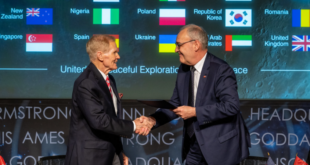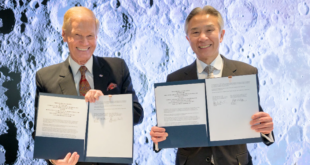Space Café “Black Ops by Dr. Emma Gatti” is our bi-monthly appointment with space geopolitics. This new series sees guest Dr. Namrata Goswami in dialogue with chief editor Dr. Emma Gatti.
India: A Strategy of a Leading Power
The fifth episode of this special series of Space Café Black Ops with Dr. Namrata Goswami as a resident guest is focused on India. This episode is part of a seven-series focused on the geopolitics of space.
Chandrayaan-3 mission
The Chandrayaan-3 mission successfully landed on the South Pole of the Moon last August, providing some critical insights we can draw about India and space. India has learned from past missions and accounted for all kinds of failure to ensure this mission would be a success.
The prediction is that the next mission for India will be to collaborate with Japan to go to the lunar South Pole to scout for water ice.
India’s space policy
The Indian Space Policy 2023 was published in May and showed the government’s plan to let private business carry out end-to-end activities from launches to operating Earth stations. It is the first time that India has put out an official space policy as it is the first time that India has officially clarified what its institutional structures will be within the nation. The major critique of the document is that “a space policy document should be much more than telling about internal bureaucratic institutional reorganisation”. India could have also included how it will focus on different civilian space missions, the timelines of those missions and national security space.
India versus China
India and China have many similarities; they both want to utilise space for their own national development, and use satellite images for weather forecasting, agriculture mapping etc. “India does not have the military capacity that China has,” Goswami pointed out during the interview. As a matter of fact, China has approximately 250 satellites that support military capability, in contrast, India has about three.
When asked if a collaboration between the two countries is possible, Goswami showed some scepticism. For these two countries “a collaborative approach in space is difficult, because of the fact that both nations have disputed territory”, she said. Frequent escalations at the borders makes a deeper collaboration not possible when it comes to space programs, she added.
India versus the US
India seems interested in developing a fruitful relationship with the US. India has signed agreements like the human spaceflight program where they will collaborate with NASA to develop US human spaceflight capability.
The two nations will also go to the International Space Station (ISS) together. “India might not fill the vacuum of Russian ISS technology, but it will bring legitimacy to the particular collaborative framework.” Furthermore, by collaborating through the Artemis Accords they will have the opportunity to build commercial, private partnerships and learn from the US on how it succeeded in motivating its private sectors.
Here you can see the episode in full:
 SpaceWatch.Global An independent perspective on space
SpaceWatch.Global An independent perspective on space





